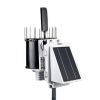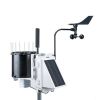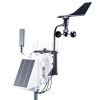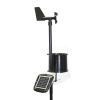Spectrum WatchDog 3210 Wireless Temperature Stations
Features
- Integrated solar power system for reliable power
- Optional Wi-Fi or cellular modem for wireless communications
- Integrated data logger holds 18 months of data at a 15-minute recording interval
- Free ground shipping
- Expedited repair and warranty service
- Lifetime technical support
- More
Overview
The fully integrated WatchDog 3210 Wireless Temperature Alert Station measures temperature and humidity, recording and communicating the data to the cloud using its optional internal modem or radio. Receive alerts via automated phone call, text message, and/or email immediately when temperature crosses your selected threshold - no waiting for the next scheduled upload.
Benefits
- Integrated Solar Power system for reliable power.
- Integrated Modem/Radio for reliable communications: available with a choice of cellular modems or other radios.
- Integrated Data Logger protects your data. Holds over 18 months of data at a 15-minute recording interval. Data can be transferred to a USB flash drive.
- Easy to install - be running in minutes. Mounts to a 1.25 inch mast. U-bolts included.
- Bluetooth connectivity to your Apple or Android smartphone running the free WatchDog Mobile App speeds setup and displays current conditions.
- Sends data to the SpecConnect Cloud Solution - View current conditions or historical data using a broad selection of analytical reports from anywhere in the world.
- Customizable with plug-in sensors to meet your needs
- Receive the latest changes with over-the-air updates (also available via a USB flash drive).
- Durable enclosure provides moisture, corrosion, and UV protection for increased reliability in harsh environments.
- Designed and manufactured in the USA to provide the quality data you can rely on.
- External Communication: Cellular, USB, Bluetooth, RS232
- External Sensor Ports: 1 x 2.5mm stereo jack (0 to 3.0VDC analog input)
- Data Capacity: 30,000 data intervals can be stored on the unit before the oldest record is overwritten by the newest data (312 days at 15 minute intervals).
- Dimensions(w/Antenna): 19.5 in (49.53 cm) H x 19.5 in (49.53 cm) L x 11.25 in (28.58 cm).
- Weight: 9.90 lbs. (4.49 kg)
- Power Source: 3.5W solar panel, Rechargeable 6V/4.5AH SLA battery, optional AC/DC power adapter.
- Battery Life: 14 days minimum with no solar power.
- LED: 3-color (Red, Amber, Green)
- Operating Temperature Range: -22° to 130°F (-30° to 55°C)
In The News
Sargassum Surge: How Seaweed is Transforming our Oceans and Coastal Ecosystems
Until recently, Sargassum –a free-floating seaweed–was distributed throughout the Sargasso Sea , the north Caribbean Sea, and the Gulf of Mexico. But in the space of a decade, this seaweed has, as one scientist remarks , “Gone from a nonfactor to the source of a terrible crisis.” Driven by climate change, anomalous North Atlantic Oscillation in 2009-2010 and a glut of anthropogenic pollutants, sargassum has proliferated. Seasonally recurrent mats as deep as 7m now bloom in the “Great Atlantic Sargassum Belt” (GASB), which covers areas of the Atlantic from West Africa to the Caribbean Sea and Gulf of Mexico. Every year, millions of tons wash up along the shores of more than 30 countries . Dr.
Read MoreGreat Lakes Research Center: Designing Targeted Monitoring Solutions
According to the National Oceanic and Atmospheric Administration ( NOAA ), the Great Lakes have more miles of coastline than the contiguous Atlantic and Pacific coasts combined and contain 20 percent of the world's freshwater, making it a critical region to protect and conserve. Continuous monitoring and data-informed resource management are key components of managing waters in the region. Hayden Henderson, a research engineer with the Great Lakes Research Center (GLRC), designs and deploys monitoring platforms throughout the Great Lakes. With a background in environmental engineering, Henderson enjoyed the challenge of creating systems and making them work to obtain difficult, remote measurements.
Read MoreMonitoring Meadowbrook Creek: Real-Time Data Collection in an Urban Creek
Meadowbrook Creek in Syracuse, New York, has been monitored by Syracuse University (SU) faculty and students for over a decade. Originally established by Dr. Laura Lautz in 2012, the early years of the program focused on collecting grab water samples for laboratory analysis and evaluating the impact of urban land use, human activities, and natural processes on water resources. Tao Wen , an Assistant Professor in SU’s Department of Earth and Environmental Sciences, took over the program in 2020 and upgraded the existing systems to include 4G modems that allowed for real-time data viewing. [caption id="attachment_39339" align="alignnone" width="940"] An overview of the Fellows Ave monitoring station along Meadowbrook Creek.
Read More




























